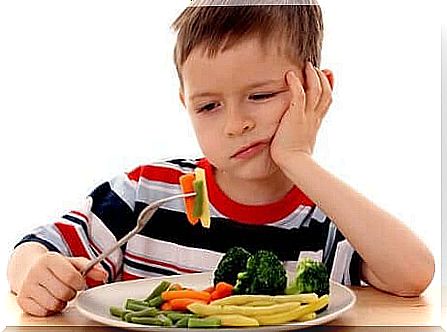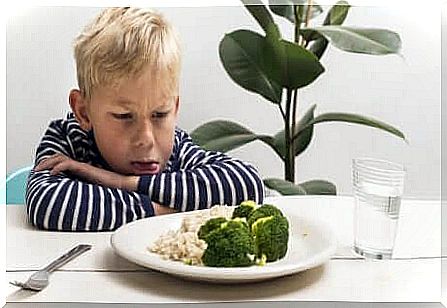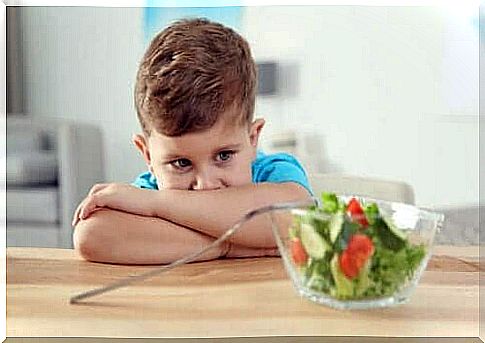Try This For Children Who Refuse To Eat Vegetables

Children who refuse to eat vegetables abound in the world. Their reactions to these foods are almost universal: wrinkle their nose, turn their head, frown or dig into the dish until they find something attractive to the palate.
Some parents see this behavior as a sign that they are spoiled, but it is simply the way it is. There are organic factors that trigger them, there are even causes of evolutionary origin. Contrary to popular belief, this rejection is more related to the color of the vegetables than to the taste.
The brain’s defense mechanisms

The brain is the result of a transformation over thousands of years, and still has defense mechanisms to protect living beings from contaminated and toxic substances. This explains why some foods with strong colors, such as vegetables, trigger danger signals in the brain, and instinctively trigger an aversion to them.
When it comes to colors, shades of green and orange in meals lead to denial in young children. This is why many children between the ages of three and five get to know a potato faster than broccoli or Brussels sprouts.
Although these actions are part of the natural growth process of a child, it is the parents’ responsibility to promote the gradual incorporation of these foods which represent the greatest source of fiber, minerals and vitamins.
High sensitivity

Taste sensitivity has been shown to have an important genetic component. The gustatory and olfactory perception is very developed in the first years of life, and that is why many children show difficulties in tolerating foods other than breast milk or breast milk substitute.
To that we must add the low level of calories that vegetables have and the bitter taste that characterizes most of them. All this will begin the so-called digestive neophobia (instinctive rejection of food).
It is the loss of receptors or their inability to transform gustatory and olfactory stimuli into nerve signals that cause sensitivity to decline over time.
Try tasty options

Children who refuse to eat vegetables tend to underestimate dark leafy vegetables, such as Swiss beetroot, eggplant, spinach, cucumbers and radishes. They tolerate sweet potatoes, ripe tomatoes and those with greater sweetness a little better.
The positive thing about all of this is that just as the brain is prepared to exclude anything that could pose a threat, it is also able to change through experience or frequent exposure to certain habits.
Therefore, experts say that to overcome the “contempt” for vegetables, you should encourage your child to taste delicious dishes that contain the same taste between 12 and 14 times. Only then will the brain rule out the risk of toxicity.
This is how you can deal with children who refuse to eat vegetables

The worst mistake adults can make is encouraging food rejection. Children who refuse to eat vegetables will be deprived of a good proportion of potassium, sodium, magnesium, calcium and vitamin K.
In addition, they will receive smaller amounts of antioxidants and vitamin A, which guarantees good health for skin, tissues and mucous membranes. Similarly, they will expose the body to inadequate doses of carbohydrates, which is important in preventing intestinal disorders and constipation.
Every child has their own style of eating, and even if they do not want to starve, it is necessary to correct this rejection of vegetables.
Tips to consider for children who refuse to eat vegetables
- Lead by example, try to eat with your family.
- Do not include new foods as often. The ideal frequency is every other day.
- Keep in mind that variety and colors do not help. The practicality is to offer them one vegetable at a time, at least in the first phase.
- Do not force them to eat large portions. Starting with small pieces is the most practical.
- Vary the preparation. If they do not tolerate the vegetable itself, you can add it to a recipe as they wish. Juices and pastries are not the best options.
- Cut into small pieces. The feeling of being able to eat food with your hands will attract attention.
- Avoid pressure, punishment and threats.
- Always add vegetables after the age of three. You should get them used to trying it.
- Take advantage of your appetite. If they are hungry, it is very possible that they will eat it.
- Maintain patience and calm, always with positive reinforcement instead of arguing.
- Appeals for verbal rewards. Phrases like “Well done”, “See how much you grow”, can motivate them.
- Do not introduce food early and abruptly.
These suggestions usually give good results. They may not apply to all vegetables, but it is unlikely that the child will like all species; three or four may be enough in the beginning.
It must be remembered that each process takes time, and far from rewarding or judging it, the child should learn that they should eat healthy on their own initiative and for their own well-being.









